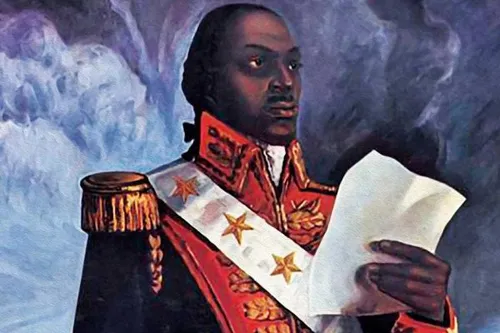
Toussaint Louverture led the Haitian revolution that won the liberation of tens of thousands of black slaves from the former French colony in Haiti and paved the way for the proclamation of its independence in 1804.
This text is part of the book Haiti, two centuries of Historypublished by Alameda and a tribute that recalls the death of the hero of the Haitian revolution on April 7, 1803.
With the French revolution of 1789, in which the revolutionary bourgeoisie destroyed the old feudalism and eliminated the privileges of the aristocracy, black slaves in Haiti saw a light at the end of the tunnel. In 1794, the revolutionary Convention then led by the Jacobins approved the abolition of slavery in France and its colonies. Haiti’s black slaves gained strength in their libertarian impulse.
In March 1793, with the declaration of war by Spain and England against revolutionary France due to the execution of Louis 16, the authorities of the Spanish colony of Santo Domingo began to get directly involved in the affairs of the French colony. Former cooperation with France has ended. The Spanish decided to use the rebellious slaves to expel the French from the island and recover the territory for Spain.
Rebel leaders Jean François, Jean Biassou and Toussaint Louverture initially accepted the help offered by Spanish commanders at the border posts to fight for their freedom. Facing a triple offensive from British, Spanish and rebellious slaves, French colonial authorities decreed the abolition of slavery on August 29, 1793, seeking to gain the support of the black population. A number of French owners did not accept it. But the liberation decree yielded results and in May 1794 one of the three most important leaders of the rebels, Toussaint Louverture, joined the French with his troops.
The rebellion of black slaves was decisive in confronting the actions of the counter-revolutionary French led by César Galbaud and against the liberation of slaves. The alliance of Toussaint’s troops with those of the French revolutionary republic and its national commissioners Sonthonax and Polverele allowed them to defeat the English, Spanish and Galbaud himself, who fled to the USA on June 24, 1793.
In October 1794, the offensive of French forces made up essentially of Toussaint’s black men forced the Spanish to abandon their border posts and retreat. At that moment, news arrived that Spain’s war against France had ended in Europe. The Basel treaty had been signed in which France would return the territories conquered on the Iberian peninsula in exchange for the Spanish part of the island of Santo Domingo. The treaty established that the Spanish inhabitants would have one year to move.
To the dismay of the Spanish colonists, the French, defended mainly by black soldiers, became official owners of the entire island overnight and against centuries-old Spanish resistance. The Spanish colonists, however, began to react against the agreement. In the Catholic church there were divisions and some priests wanted to remain out of sympathies with the French revolution or because they distanced themselves from the traditional church.
But the Spanish withdrawal began and in April 1796 around 1800 people left the island. The French, on the other hand, wanted to retain the Spanish slave-owning population who had been shocked by French abolitionist policies. The slave revolt reached the Spanish side. In October 1796, around 200 slaves from the Bocanigua plantation rebelled against their owners, increasing the fear of a general insurrection among the black population. The Spanish governor gradually tried to hand over areas of the colony to the French. The situation has become more complex.
In March, French commander Donatien Rochambeau refused to take possession of the territories ceded by the Spanish using troops of black soldiers. In the meantime, the English offensive was resumed, which forced the French commander to postpone the occupation of the entire island with white troops. In late 1796 Britain declared war against Spain. The Spanish governor concentrated his troops in the capital of Santo Domingo and practically abandoned the interior regions. In March 1797 there were 1116 soldiers in the city. In 1798 and in the following years the governor’s problem depended completely on what would happen in Santo Domingo and in France. At the end of April 1798 the English were defeated.
At the end of March 1798, a new French mission arrived, whose main concern was to take political and military power from the black leader Toussaint Louverture. The French envoys had to abandon the island in October.
From February 1799 to August 1800 no officially authorized representative of the French government took possession of Spanish Santo Domingo. Fighting against the forces of General André Riad, Toussaint’s troops were unable to unify the island as they wished and complete the liberation of the territory.
It should be noted that its initial objective was not the independence of Haiti, but the autonomy of the island with freedom for black people in the context of a revolutionary and democratic French republic. But he did not receive authorization from the Paris government to enter the former Spanish colony. The revolutionary situation in France had undergone major transformations, the Jacobins were defeated and guillotined.
A more conservative fraction of the French bourgeoisie, the Girondins, under the Directory governments came to power willing to review many of the most radical measures of the revolution, including the abolition of slavery. The rise of Napoleon consolidated the conservative turn of the revolution. It was indeed a serious inconvenience to the plans of Napoleon and the French bourgeoisie to have a black general and an army of freedmen at the head of the ancient and rich colony. In May 1800, messengers from the French government reported that Toussaint was not authorized to take possession of the Spanish part of the island under penalty of death. But the black general forced the French representative to sign the authorization to occupy Santo Domingo in June 1800.
On January 26, 1801, Toussaint occupied the capital of Santo Domingo. He took measures to respect the inhabitants and improve the administration. He improved the roads and tried to implement an agrarian revolution to transform the entire production system of the former Spanish colony. He created courts of first instance in both parts of the island. He ordered an accurate inventory of available resources to be made and abolished several taxes. He sought to win the favor of the owners of the former Spanish side of the island who he knew hated him.
Slavery was immediately abolished with a decree of August 27, 1801. A monetary system was implemented to facilitate the regions’ financial operations. He also took steps to limit the granting of land to new owners. He tried to introduce the plantation of sugar cane, coffee, cotton and cocoa to overcome the poverty of the former Spanish colony, which was limited to cattle raising.
The reaction of Napoleon and the French metropolis paralyzed the ongoing agrarian and social revolution. With the temporary end of the war in Europe, France had time to look at the Americas. Napoleon saw the retaking of Haiti as a strategic support point to enhance the exploration of French Louisiana (later sold to the USA). It was also necessary to take advantage of the peace with England that allowed the French fleet to sail freely across the Atlantic without facing English naval power.
In January 1802, around 20,000 men were dispatched under the command of General Charles Victor Emmanuel Leclerc to crush Toussaint’s forces. In February 1802, the gigantic French expedition occupied the capital of Haiti to reestablish slavery in Santo Domingo. The Spanish fully supported the French invasion and likewise the mestizo population on the French side, who were mostly property owners, more sympathetic to the French and unable to accept a black government.
The caste policy based on skin color implemented by former French colonists to try to divide black people had had its effects, even though the central social division was delimited by property ownership. A military government was also established by France in the Spanish part of the island.
On May 5, 1802, Toussaint negotiated the surrender. A month later the French who had secured his freedom arrested him and took him to Europe. For months he was tortured and interrogated at Fort-de-Joux in France’s icy Jura Mountains. As the Caribbean historian CLR James recorded: “Napoleon decided to kill him through ill-treatment, cold and hunger.”
Toussaint was then 57 years old and would die in the cold, damp dungeons, far and isolated from his hot and vibrant Haiti, on April 7, 1803.
The restoration of slavery on the island and French colony of Martinique had made it clear to the already experienced Haitian generals led by Toussaint such as Jean Jacques Dessalines, Alexandre Pétion and Henry Christophe that the same would soon happen in Haiti. Resistance was rearticulated and the revolution began again. The French commander, General Leclerc, died in November 1802 and was replaced by General Donatien Rochambeau.
During this same period, the war between France and England resumed in Europe. Reinforcements for French troops in Haiti decreased with the intensification of fighting in Europe and the action of the English fleet blocking French boats. In April 1803 Napoleon ended his colonial ambitions in America by selling the immense Louisiana to the USA, from which he certainly expected support for the war against England.
In November 1803, French general Rochambeau withdrew to Jamaica. The remaining French troops retreated to Spanish Santo Domingo and abandoned French territory definitively. Total victory would occur in 1804 with the Proclamation of Haitian Independence and led by one of Toussaint Louverture’s generals, Jean Jacques Dessalines.
Editing: Rodrigo Durão Coelho

Source: www.brasildefato.com.br

